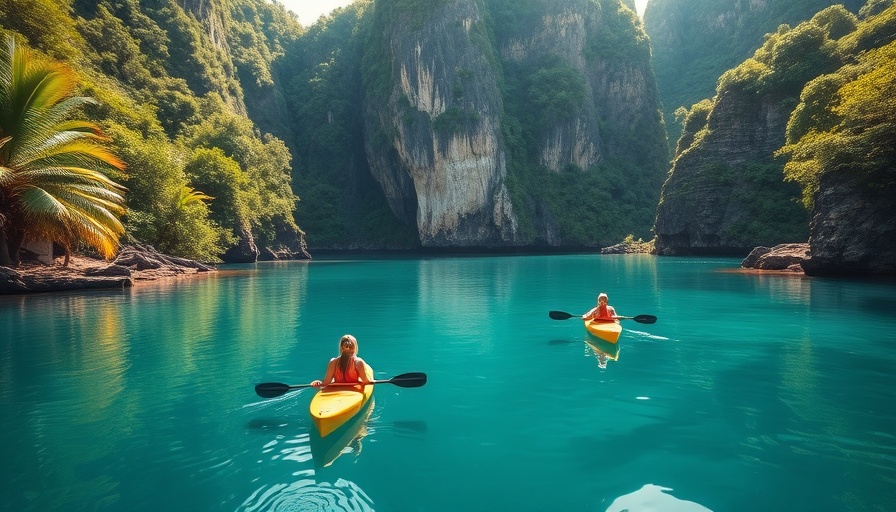
Discovering Hidden Paradise: The Ecotourism Revolution in the Philippines
The picturesque islands of the Philippines are slowly becoming the focal point of an ecotourism boom, as local communities strive to balance economic gain with environmental conservation. The country’s pristine destinations, which once fell under the radar, are now emerging as sustainable tourism hotspots, inviting eco-conscious travelers to explore their untouched beauty.
From Fisheries to Tourism: A Community Transformed
Jose “Jojo” Mazo, a ranger at Siete Pecados Marine Park, embodies the shift toward sustainable tourism. In the span of just two decades, areas like Coron Island have transitioned from illegal fishing hotspots to eco-friendly tourism destinations. Mazo recalls the rampant destructive fishing methods that plagued the area, but now, tourism constitutes the backbone of the economy. “Because of our work, respect towards the environment has increased,” Mazo iterates. The park has limited daily visitors, ensuring a sustainable approach that gives back to the community.
This trend is mirrored in other regions as well; Bantayan Island has made its mark with community-led tourism initiatives that allow locals to harness both their culture and natural resources. Decisions around tourism are increasingly led by local communities, highlighting a transparent and sustainable operating model that helps mitigate the impact of increased visitors.
Enhanced Connectivity Fuels Growth
The introduction of more direct flights to remote islands is stimulating growth in the tourism sector. For example, the Francisco B Reyes Airport significantly reduced travel time to Coron Island, making it accessible to a wider audience. With emerging budget airlines expanding routes, the rise in tourist footfall is translating not only to economic benefits but also to funding for conservation projects. Mazo mentions that such initiatives help sustain marine ecosystems and provide locals with new employment opportunities, diving into diverse roles such as eco-guides.
Lessons from Overtourism: The Balancing Act
However, the burgeoning interest comes with challenges. The Philippines has learned from past experiences, such as those in Boracay, where unchecked tourism led to environmental degradation. Moving forward, it is imperative to implement rigorous regulations to protect these beautiful yet vulnerable ecosystems. Experts argue for a balance between tourism and preservation, implementing carrying capacity limits and promoting awareness of responsible travel practices.
Moreover, the recent push by the Department of Tourism to partner with other countries reflects an intention to boost not just tourism volume but quality. By establishing sustainable frameworks and respecting local communities, officials hope to enhance the tourism experience while safeguarding the islands' natural charm.
Future Directions: Ecological Integrity Meets Economic Opportunity
The future of the Philippines' tourism landscape hinges on sustainable practices, as highlighted by investments in renewable energy within the sector. Harnessing resources such as solar power, provinces like Bohol are working towards eliminating their carbon footprint associated with tourism.
This balanced growth strategy comes with consensus building among stakeholders—from local governments to private enterprises. Community members take active roles in the decision-making process, ensuring that their voices are heard and their needs are met. This not only fosters an inclusive development model but also nurtures a sense of ownership and stewardship over the environmental treasures of the islands.
Empowerment Through Responsibility
Ultimately, the burgeoning ecotourism industry presents opportunities for stronger local economies while encouraging a culture of conservation and responsibility. The environmental initiatives led by locals allow them to be part of the solution, creating ecosystems that thrive rather than merely survive amidst the pressures of tourism.
As travelers seek out destinations like Coron and Bantayan Island, they are also contributing to the momentum of sustainable practices in the region, opting for experiences that resonate with their eco-conscious lifestyles. It is a win-win situation, where exploration and stewardship go hand in hand, forming a sustainable cycle of growth.
By focusing on long-term solutions for both economic resilience and ecological preservation, the Philippines is on its way to becoming a model for sustainable tourism that other nations could emulate.
Join the Movement for Sustainable Travel
If you're inspired by the stories of communities championing their ecological treasures while benefiting economically, consider supporting eco-friendly travel initiatives. Making conscientious travel choices and advocating for responsible tourism can play a significant role in protecting these beautiful destinations. Together, we can foster a sustainable future.
 Add Row
Add Row  Add
Add 



Write A Comment